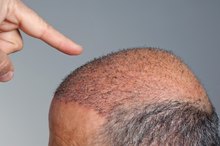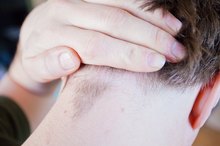What does fact checked mean?
At Healthfully, we strive to deliver objective content that is accurate and up-to-date. Our team periodically reviews articles in order to ensure content quality. The sources cited below consist of evidence from peer-reviewed journals, prominent medical organizations, academic associations, and government data.
The information contained on this site is for informational purposes only, and should not be used as a substitute for the advice of a professional health care provider. Please check with the appropriate physician regarding health questions and concerns. Although we strive to deliver accurate and up-to-date information, no guarantee to that effect is made.
How to Remove the Residue from Glue Stitches on a Head Cut
Skin adhesive, such as Dermabond or SurgiSeal, is an excellent alternative to stitches or staples because it requires no anesthesia and it normally falls off naturally, so a second doctor's visit is not required to remove it, as with stitches 1. But, depending on where the wound is located on the body, sometimes the glue patch does not fall off easily and some intervention may be required.
Evaluate the need to remove the adhesive. Skin adhesive, or "glue stitches," is designed to loosen and fall off when the wound has healed. Under normal circumstances, it should not be removed. However, if the wound is healed and the glue has loosened and is stuck to hair, it may take longer than normal to fall off on its own.
Dangers of Hair Transplants
Learn More
Determine whether the wound is healed or if there is an infection. If the wound is not healed, you should not remove the adhesive except at the advice of your doctor. If there is an infection, you should contact your doctor. Signs of an infection include redness, especially more redness than there was previously, pain and swelling, a warm area around the wound, and any leaking fluid, especially a fluid that is not clear and not blood.
Examine the area and the patch of glue residue and determine whether the glue is, in fact, stuck to the skin itself, or if it is stuck to hair.
Home Treatment for Vaginal Ingrown Hairs
Learn More
If the glue is stuck to skin, you may want to wait a day or two more before you try removing it. In areas where no hair is involved, you should first try picking at the edges and then rolling the largest part of the residue away from the skin. Be careful not to re-open the wound. This should really only be done at least two weeks after the glue was first applied.
If the glue is stuck to hair, and the wound is healed, you have a couple of options. You can cut the hair holding the glue patch and remove it that way. If you are unwilling to cut the hair, you can try loosening the glue from the hair with vegetable oil. Work it in; it may take a few minutes. If it doesn't work, or if the glue only comes loose from some of the hair, you will have to cut the rest of the hair. And then, of course, you will need to wash the vegetable oil out of the hair.
Tips
If you have a head wound that is within the hairline and the doctor recommends skin adhesive, it might be best to shave a very small area before applying the skin adhesive. The rest of the hair will fall over the temporary bald spot and the hair will grow back soon. If the glue gets on the hair, the hair is likely to need cutting anyway, to remove the glue residue. Part the hair and hold it away from the cut until the glue dries.
Warnings
The purpose of skin adhesive is to keep the wound closed until it heals. This usually takes the same amount of time as it does for the glue to naturally loosen and fall off because of the growth of new skin. If you want it off sooner, you need to consider whether it is wise to remove it. The most common reason for removing it early would be if an infection has developed in the wound, or if the wound is not healing properly.
Related Articles
References
- SurgiSeal FAQ
- Cuts, Scrapes and Stitches: Caring for Wounds
- Bhargava R. Superglue in First Aid Boxes. International Journal of First Aid Education. 2018;2(1). doi:10.21038/ijfa.2018.0001
- Champagne, C. "Serendipity, Super Glue and Surgery: Cyanoacrylates as Hemostatic Aids in the Vietnam War".The Proceedings of the 18th Annual History of Medicine Days, March 6th and 7th, 2009 University of Calgary, Faculty of Medicine, Calgary, AB. p. 155-176
- González JG. Cianoacrilato: Definición y propiedades. Toxicidad y efectos secundarios. Aplicaciones en medicina y odontología. Avances en Odontoestomatología. 2012;28(2):95-102. doi:10.4321/s0213-12852012000200006
- Gulalp B, Seyhan T, Gursoy S, Altinors MN. Emergency wounds treated with cyanoacrylate and long-term results in pediatrics: a series of cases; what are the advantages and boards?. BMC Res Notes. 2009;2:132. Published 2009 Jul 14. doi:10.1186/1756-0500-2-132
- Jones C, Ho W, Samy M, Boom S, Lam W. Comparison of glues, sutures, and other commercially available methods of skin closure: A review of literature. Medical Research Archives. 2017;5(7). doi:10.18103/mra.v5i7.1419
- Should Super Glue Be in Your First Aid Kit? Mayo Clinic. https://mayoclinichealthsystem.org/hometown-health/speaking-of-health/should-super-glue-be-in-your-first-aid-kit.
- DermaBond Summary of Safety and Effectiveness Data. Food and Drug Administration. https://www.accessdata.fda.gov/cdrh_docs/pdf/P960052b.pdf.
Tips
- If you have a head wound that is within the hairline and the doctor recommends skin adhesive, it might be best to shave a very small area before applying the skin adhesive. The rest of the hair will fall over the temporary bald spot and the hair will grow back soon. If the glue gets on the hair, the hair is likely to need cutting anyway, to remove the glue residue. Part the hair and hold it away from the cut until the glue dries.
Warnings
- The purpose of skin adhesive is to keep the wound closed until it heals. This usually takes the same amount of time as it does for the glue to naturally loosen and fall off because of the growth of new skin. If you want it off sooner, you need to consider whether it is wise to remove it. The most common reason for removing it early would be if an infection has developed in the wound, or if the wound is not healing properly.
Writer Bio
Melissa Worcester is a mom, freelance writer and graphic designer. She has been writing professionally for over 18 years and earning a part-time income writing for various websites since 2007. She writes about technology issues, business and marketing, home improvement, education and family topics and assists in her husband's home remodeling business. Worcester has a Bachelor of Arts in communications and psychology from Syracuse University.








